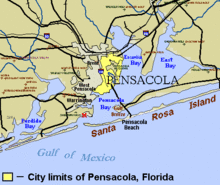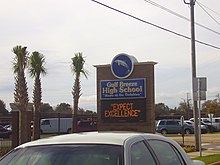Gulf Breeze, Florida
 From Wikipedia - Reading time: 12 min
From Wikipedia - Reading time: 12 min
Gulf Breeze, Florida | |
|---|---|
| City of Gulf Breeze | |
 Entrance sign and median in Gulf Breeze, FL heading East on Hwy 98, July 2013 | |
 Location in Santa Rosa County and the state of Florida | |
| Coordinates: 30°21′26″N 87°9′50″W / 30.35722°N 87.16389°W | |
| Country | |
| State | |
| County | Santa Rosa |
| Incorporated | August 10, 1961 |
| Government | |
| • Type | Council-Manager |
| • Mayor | Cherry Fitch |
| • Mayor Pro Tem | Tom Naile |
| • City Council | JB Schluter, Randy Hebert, and Todd Torgersen |
| • City Manager | Samantha D. Abell |
| • City Clerk | Leslie A. Guyer |
| Area | |
• City | 22.14 sq mi (57.34 km2) |
| • Land | 4.68 sq mi (12.12 km2) |
| • Water | 17.46 sq mi (45.22 km2) |
| Elevation | 16 ft (5 m) |
| Population (2020) | |
• City | 6,340 |
| • Density | 1,354.70/sq mi (523.10/km2) |
| • Metro | 509,905 (Pensacola metropolitan area) |
| Time zone | UTC-6 (CST) |
| • Summer (DST) | UTC-5 (CDT) |
| ZIP codes | 32561, 32562, 32563[2] |
| Area code | 850 |
| FIPS code | 12-28000[3] |
| GNIS feature ID | 283485[4] |
| Website | https://cityofgulfbreeze.us/ |
Gulf Breeze is a city in Santa Rosa County, Florida. It is located between Downtown Pensacola and Pensacola Beach, and is part of the Pensacola Metropolitan Area. The population was 6,340 at the 2020 census, up from 5,763 at the 2010 census.
Gulf Breeze is the nearest city to Pensacola Beach, and provides utility services to the island, and most of South Santa Rosa County covering over 33 square miles. The census designated places of Oriole Beach, Tiger Point, and Midway are considered to be apart of unincorporated Gulf Breeze by Santa Rosa County, and carry Gulf Breeze mailing addresses.
History
[edit]The area now known as Gulf Breeze was originally settled in the mid-18th Century by the British.[5] Gulf Breeze's original name was Town Point. Live Oaks from the Gulf Breeze area were used for shipbuilding and blacksmiths set up ship repair shops in the town. A Confederate camp and hospital was set up in the Deer Point area of Gulf Breeze during the Civil War.
In the late 1800s, a dry dock for ship repair was built on Deadman's Island (now a nature preserve). The island was originally was a major ship quarantine area used by Pensacola.[6] Deadman's island got its name from Deadman anchors. Deadman's Island later was host to a glue factory and fertilizer plant.
The five year period between 1928 and 1933 saw large road development in Gulf Breeze. The first bridge between Pensacola and Gulf Breeze was built by Johnson, Drake & Piper. Gulf Breeze's first paved road was U.S. Highway 98, completed in 1933. A wooden swing bridge was established between Pensacola Beach and Gulf Breeze in 1931. The swing bridge was replaced by a concrete toll bridge in 1946, which was converted into Bob Sikes fishing pier in 1973.
The name Gulf Breeze comes from the Gulf Breeze Cottages and Store, where the area's first post office was established in 1936. The city was incorporated on August 10, 1961 as a result of the expansion of Pensacola Bay Bridge.[7] Gulf Breeze became famous after the 1987 Gulf Breeze UFO Incident.
Geography
[edit]The city has a total area of 23.56 square miles (61.0 km2), of which 4.68 square miles (12.1 km2) is land and 18.88 square miles (48.9 km2) is water.[8]
Growth of the city itself is geographically restricted, surrounded by major water bodies on three sides; the eastern portion of Gulf Breeze is occupied by the Naval Live Oaks Reservation. As a result, new growth takes place east of the city limits along U.S. Highway 98.
Climate
[edit]| Gulf Breeze, FL | ||||||||||||||||||||||||||||||||||||||||||||||||||||||||||||
|---|---|---|---|---|---|---|---|---|---|---|---|---|---|---|---|---|---|---|---|---|---|---|---|---|---|---|---|---|---|---|---|---|---|---|---|---|---|---|---|---|---|---|---|---|---|---|---|---|---|---|---|---|---|---|---|---|---|---|---|---|
| Climate chart (explanation) | ||||||||||||||||||||||||||||||||||||||||||||||||||||||||||||
| ||||||||||||||||||||||||||||||||||||||||||||||||||||||||||||
| ||||||||||||||||||||||||||||||||||||||||||||||||||||||||||||
Demographics
[edit]| Census | Pop. | Note | %± |
|---|---|---|---|
| 1970 | 4,190 | — | |
| 1980 | 5,478 | 30.7% | |
| 1990 | 5,530 | 0.9% | |
| 2000 | 5,665 | 2.4% | |
| 2010 | 5,763 | 1.7% | |
| 2020 | 6,302 | 9.4% | |
| U.S. Decennial Census[9] | |||
2010 and 2020 census
[edit]| Race | Pop 2010[10] | Pop 2020[11] | % 2010 | % 2020 |
|---|---|---|---|---|
| White (NH) | 5,403 | 5,573 | 93.75% | 88.43% |
| Black or African American (NH) | 19 | 19 | 0.33% | 0.30% |
| Native American or Alaska Native (NH) | 27 | 18 | 0.47% | 0.29% |
| Asian (NH) | 81 | 98 | 1.41% | 1.56% |
| Pacific Islander or Native Hawaiian (NH) | 1 | 3 | 0.02% | 0.05% |
| Some other race (NH) | 10 | 18 | 0.17% | 0.29% |
| Two or more races/Multiracial (NH) | 70 | 306 | 1.21% | 4.86% |
| Hispanic or Latino (any race) | 152 | 267 | 2.64% | 4.24% |
| Total | 5,763 | 6,302 |
As of the 2020 United States census, there were 6,302 people, 2,983 households, and 1,809 families residing in the city.[12]
As of the 2010 United States census, there were 5,763 people, 2,185 households, and 1,758 families residing in the city.[13]
2000 census
[edit]As of the census[3] of 2000, there were 5,665 people, 2,377 households, and 1,678 families living in the city. The population density was 1,192.0 inhabitants per square mile (460.2/km2). There were 2,553 housing units at an average density of 537.2 units per square mile (207.4 units/km2).
In 2000, there were 2,377 households, out of which 28.1% had children under the age of 18 living with them, 57.7% were married couples living together, 10.6% had a female householder with no husband present, and 29.4% were non-families. 25.3% of all households were made up of individuals, and 13.0% had someone living alone who was 65 years of age or older. The average household size was 2.36 and the average family size was 2.83.
In 2000, in the city, the population was spread out, with 22.3% under the age of 18, 4.6% from 18 to 24, 22.5% from 25 to 44, 29.7% from 45 to 64, and 20.8% who were 65 years of age or older. The median age was 45 years. For every 100 females, there were 89.4 males. For every 100 females age 18 and over, there were 83.6 males.
In 2000, the median income for a household in the city was $52,522, and the median income for a family was $61,661. Males had a median income of $44,408 versus $28,159 for females. The per capita income for the city was $34,688. About 3.8% of families and 4.2% of the population were below the poverty line, including 5.5% of those under age 18 and 1.2% of those age 65 or over.
Arts and culture
[edit]Points of interest
[edit]
In 1828 the U.S. government purchased the land encompassing the Naval Live Oaks Reservation for experimenting with acorns for the cultivation of live oaks to produce wooden ships. Before the Civil War, the wood of the live oak was the primary material of choice for shipbuilders, thus the protection and cultivation of the trees for the United States Navy was considered vital for defense in those turbulent times. Currently, the land comprises over 1,300 acres (530 ha) in Gulf Islands National Seashore and is supervised by the National Park Service. To the south of Highway 98 is a visitor center for the Gulf Islands National Seashore and several public beach areas.
Gulf Breeze Library
[edit]| Gulf Breeze Library | |
|---|---|
 | |
| 30°21′21″N 87°10′18″W / 30.3558°N 87.1717°W | |
| Location | Gulf Breeze, Florida |
| Established | 1971 |
| Branch of | Santa Rosa County Library System |
The Gulf Breeze Library, opened in 1971, is part of the Santa Rosa County Library System.[14][15]
Education
[edit]Gulf Breeze Academic Plaza
[edit]The Gulf Breeze Academic Plaza is a complex of 14 buildings clustered around US Highway 98 in Gulf Breeze, Florida. The GBAP consists of Gulf Breeze Elementary School, Gulf Breeze Middle School, and Gulf Breeze High School. Also included in the complex is Dolphin Field at Gulf Breeze Stadium (football, soccer, lacrosse, track and field), Dolphin Stadium (baseball), and Gulf Breeze Softball Stadium (softball).

- Gulf Breeze High School[16]
- Gulf Breeze Middle School[17]
- Gulf Breeze Elementary School[18]
Infrastructure
[edit]Gulf Breeze is served by route 61 of Escambia County Area Transit.[19][20]
Notable people
[edit]- Bob Armstrong (1939–2020), professional wrestler (longtime resident)
- Doug Baldwin (born 1988), American football player
- Ashley Brown (born 1982), singer and actress
- Ben Lively (born 1992), baseball pitcher for the Cincinnati Reds
- Jason McKie (born 1980), American football player
- Frank Spellman (1922–2017), Olympic champion weightlifter
- Abigail Spencer (born 1981), actress; born and raised in Gulf Breeze[21]
- Adrian Street (born 1940), professional wrestler (longtime resident)
See also
[edit]References
[edit]- ^ "2020 U.S. Gazetteer Files". United States Census Bureau. Archived from the original on March 18, 2021. Retrieved October 31, 2021.
- ^ "Gulf Breeze Florida ZIP Codes". December 21, 2023.
- ^ a b "U.S. Census website". United States Census Bureau. Archived from the original on May 12, 2015. Retrieved January 31, 2008.
- ^ "Gulf Breeze". Geographic Names Information System. United States Geological Survey, United States Department of the Interior. Retrieved December 21, 2022.
- ^ The Heritage of Santa Rosa County, Florida. Heritage Publishing Consultings, Inc. 2003. ISBN 1-891647-69-5.
- ^ carriestevenson (July 27, 2022). "Weekly "What is it?": Deadman's Island". UF/IFAS Extension Escambia County. Retrieved June 21, 2024.
- ^ "The Gulf Breeze Story - City of Gulf Breeze". September 12, 2013. Retrieved June 21, 2024.
- ^ "2018 U.S. Gazetteer Files". United States Census Bureau. Archived from the original on July 19, 2019. Retrieved July 19, 2019.
- ^ "Census of Population and Housing". Census.gov. Archived from the original on April 26, 2015. Retrieved June 4, 2015.
- ^ "P2 HISPANIC OR LATINO, AND NOT HISPANIC OR LATINO BY RACE - 2010: DEC Redistricting Data (PL 94-171) - Gulf Breeze city, Florida". United States Census Bureau.
- ^ "P2 HISPANIC OR LATINO, AND NOT HISPANIC OR LATINO BY RACE - 2020: DEC Redistricting Data (PL 94-171) - Gulf Breeze city, Florida". United States Census Bureau.
- ^ "S1101 HOUSEHOLDS AND FAMILIES - 2020: Gulf Breeze city, Florida". United States Census Bureau.
- ^ "S1101 HOUSEHOLDS AND FAMILIES - 2010: Gulf Breeze city, Florida". United States Census Bureau.
- ^ Sierra, Kelly (October 15, 2022). "Gulf Breeze Library closed from building damage until further notice in Santa Rosa County". WEAR. Archived from the original on November 18, 2022. Retrieved November 15, 2022.
- ^ "Staff Directory • Santa Rosa County, FL • CivicEngage". www.santarosa.fl.gov. Archived from the original on December 8, 2022. Retrieved November 15, 2022.
- ^ "GBHS Home". Archived from the original on February 5, 2007.
- ^ About us santarosa.k12.fl.us
- ^ "Gulf Breeze Elementary -SRCDS". Archived from the original on February 8, 2007.
- ^ "Archived copy" (PDF). Archived from the original (PDF) on September 17, 2013. Retrieved November 26, 2013.
{{cite web}}: CS1 maint: archived copy as title (link) - ^ "Route Map". www.goecat.com. Archived from the original on September 28, 2013. Retrieved April 23, 2018.
- ^ "Abigail Spencer Biography". www.buddytv.com. Archived from the original on October 30, 2014. Retrieved April 23, 2018.
 KSF
KSF
